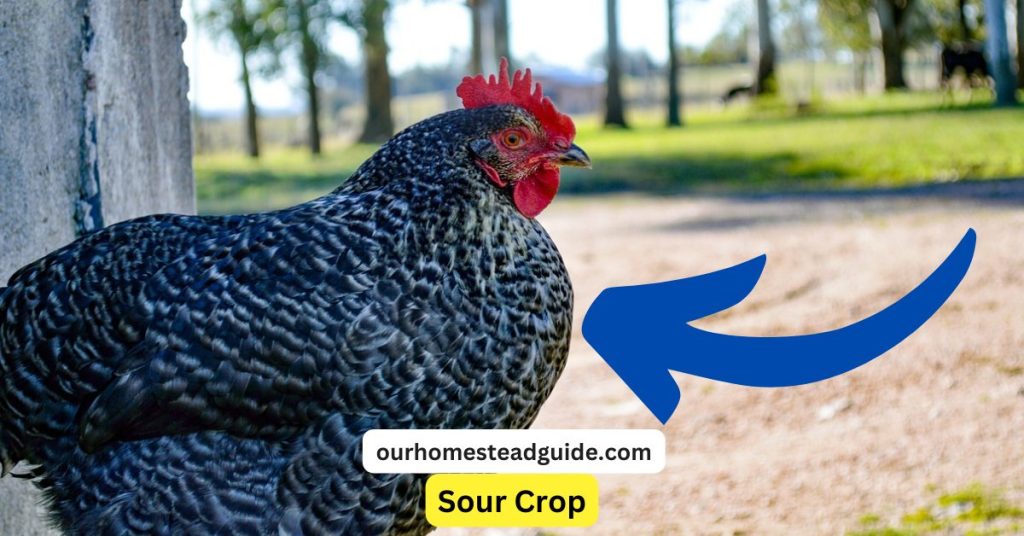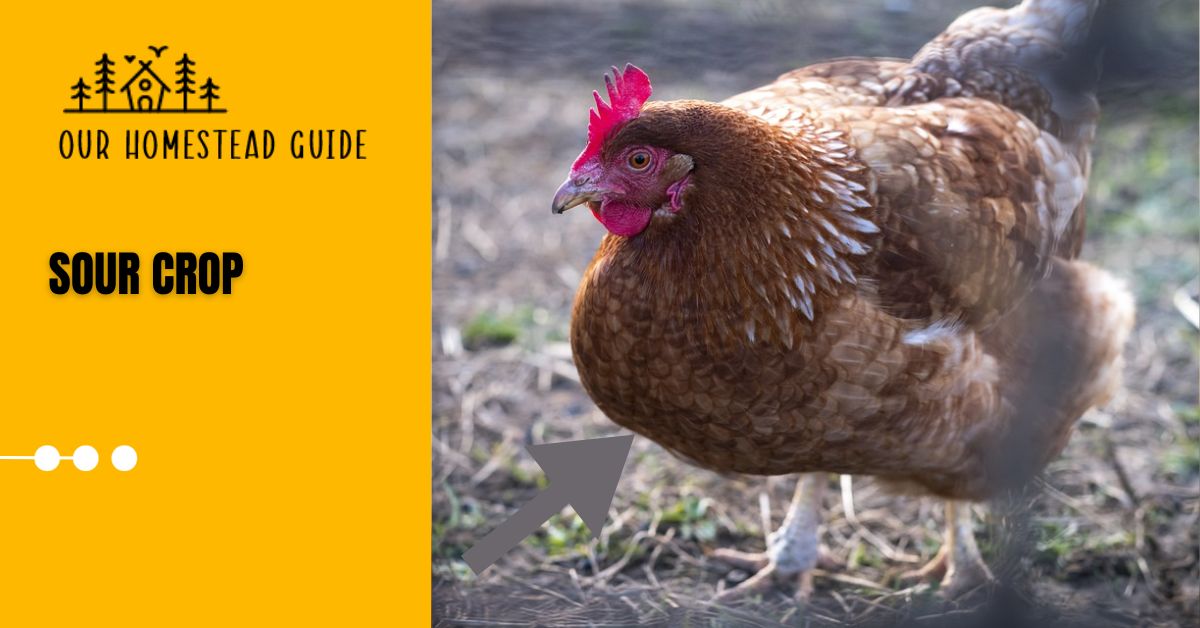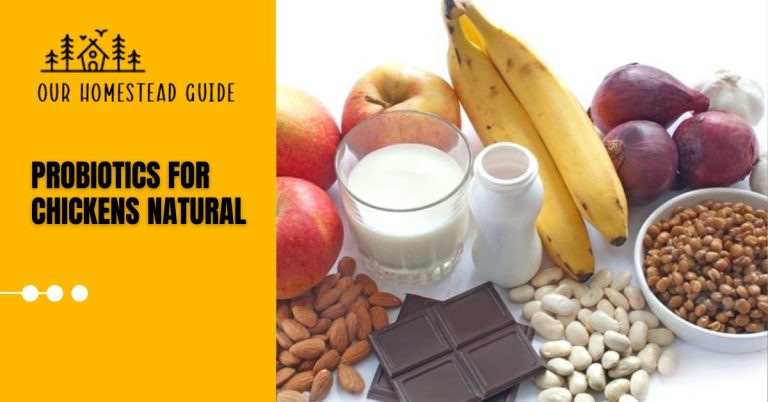Sour Crop What is And How to Treat it Complete Guide
Sour crop, a yeast infection in the bird’s esophagus, leads to thickening and dilation of the crop wall, jeopardizing the bird’s health and potentially causing fatality. Disruption of the normal crop bacteria allows an overgrowth of Candida, a fungal species, to occur.

Located at the base of a chicken’s neck, the crop is integral to early digestion, and owners seek assistance when their birds display symptoms such as an enlarged crop, lethargy, and stopped eating, often accompanied by bad breath and large fluid-filled crops.
What is Sour Crop in Chickens?
A yeast infection of the crop, a temporary storage pouch in the bird’s digestive tract situated just to the right of the breastbone, is the defining feature of a sour crop in chickens. This illness is brought on by the naturally existing bacterium Candida albicans in chickens.

The equilibrium of microorganisms in the crop can be upset by several factors, including sluggish crop emptying, an affected crop, antibiotic treatment, infections, or consumption of long, tough grasses.
These factors can cause the crop to enlarge and thicken its wall. Swelling and spongy crops, foul-smelling, behavioral abnormalities, and, if treatment is not received, possible weight loss and death are among the symptoms.
The chicken must be kept apart, fasted, massaged gently, and fed again gradually as part of the treatment. Keeping things clean, giving clean water, and keeping an eye on your food to stave off future problems are all examples of preventive actions. For the early identification and prevention of sour crops in hens, routine health examinations are crucial.
Certainly! Here’s a concise table summarizing the steps for recognizing, treating, and preventing sour crops in chickens, along with additional information:
| Step | Procedure |
|---|---|
| 1. Recognize Symptoms | – Check for a swollen, boggy, or squishy crop. – Look for a putrid sour smell from the bird’s breath. – Notice whitish patches in the bird’s mouth. – Observe changes in behavior (depression, loss of appetite, occasional diarrhea). – Note fluid from the beak. |
| 2. Isolate Affected Chicken | – Remove from the flock to prevent further consumption. – Withhold food and water for the first 12 hours to allow digestive rest. |
| 3. Gentle Massage | – After fasting, perform a gentle top-to-bottom crop massage every few hours. |
| 4. Introduce Clear Water | – Discuss potential causes of the sour crop (slow emptying crop, impacted crop, antibiotics, infection, worms, injuries, long tough grasses, strange diets, moldy food). |
| 5. Gradual Introduction of Food | – If the crop is flat, reintroduce small meals (scrambled eggs, plain yogurt, pellets, water). – Feed frugally for the first day or two with 3-4 small meals. |
| 6. Fluid Expulsion (if needed) | – If leaking fluid, cautiously help expel fluid from the crop (up to 4 times a day). – Avoid aspiration into the lungs. |
| 7. Veterinary Assistance (if necessary) | – If no improvement or severe, consult a vet. – Vet may prescribe medications like nystatin or other anti-fungal treatments. |
| Prevention Tips | – Ensure clean, fresh water is always available. – Add apple cider vinegar to water for gut acidity. – Include digestive aids (oregano, fennel seeds, parsley, garlic) in the diet. – Limit starchy foods; feed yogurt with probiotics occasionally. |
| – Prevent intake of long fibrous weeds and grasses. – Provide access to grit for digestion. – Conduct regular health checks. | |
| Additional Information | – Discuss potential causes of sour crop (slow emptying crop, impacted crop, antibiotics, infection, worms, injuries, long tough grasses, strange diets, moldy food). |
What Causes Sour Crop?
Sour crop is a fungal illness of the crop in hens, commonly referred to as candidiasis or thrush. The crop is a muscle sac that stores food before it goes into the gizzard to be digested. It is situated close to the base of the neck.

The overgrowth of Candida albicans yeast, which is often found in the digestive tract of chickens, can result in food fermentation in the crop, which can produce many symptoms including the infamous sour smell.
The following are a few of the most typical reasons hens have bad crops:
Crop slow emptying: There are several reasons why this might occur, including stress, disease, or dietary changes. Food that is left in the crop for an extended period fosters the growth of yeast.
Impacted crop: This happens when food or foreign things obstruct the crop, preventing food from passing through to the gizzard. Additionally, this may result in a sour crop and yeast overgrowth.
Antibiotics: Antibiotics can upset the regular bacterial balance in the digestive system, which promotes Candida albicans overgrowth.
Infection: Other illnesses, including coccidiosis or worms, might compromise the immune system and increase the sensitivity of hens to sour crops.
Diet: Feeding rotten or moldy food to hens, or feeding them a diet heavy in sugar or carbs, might cause yeast overgrowth.
Stress: Unusual schedules, loud noises, and crowded quarters can all impair hens’ immune systems and increase their vulnerability to sour crops.
You may take action to stop sour crops if you are aware of their causes. Here are some pointers:
- Give your hens a tidy, stress-free space to live.
- Give them a nutritious, well-balanced diet that is minimal in sugar and carbs.
- Ensure that they always have access to fresh, clean water.
- If antibiotics are not essential, do not give them.
- They should routinely check their crops for symptoms of sour crops, such as fullness, gurgling noises, or bad smells.
Understanding a Chicken’s Digestive System

The intricate mechanism of a chicken’s digestive system is essential for digesting food and drawing nutrients out of it. When food is first consumed, the trip starts in the mouth. It then passes into the crop, a storage pouch situated just to the right of the breastbone, after passing down the esophagus.
The crop serves as a makeshift holding place that enables the bird to eat food rapidly and assimilate it gradually. The partially broken down food then travels to the proventriculus, where enzymes help finish its breakdown before it reaches the gizzard.
The gizzard is a muscular organ that uses its strong muscular activity and accumulated grit to break down food into an easily digested paste. Nutrients and water are absorbed as the meal travels through them, and any leftover waste is expelled as chicken feces. After feeding, the crop looks full, and this helps with nocturnal digesting.
Comprehending this digestive process is crucial for identifying and managing problems like sour crops, wherein alterations to the typical bacterial flora can result in health difficulties for hens. Chickens’ well-being and digestive systems are maintained by routine health examinations, appropriate diet, and preventative measures.
What is a crop?
The crop is a portion of the digestive system seen in birds that is situated at the base of the neck, right before the esophageal (or food pipe) opens into the stomach. It is a muscular, enlarged pouch that acts as a short-term food storage place before food is sent to the stomach for further processing.
The crop helps birds absorb nutrients more effectively by enabling them to swallow a large amount of food at once and process it gradually. It is palpable on the outside, and you may occasionally feel what’s inside—food, dirt, or water.
Sour Crop Symptoms
When a chicken is fully grown, its crop will feel mushy to the touch and will have noticeable swelling. In theory, the crop should empty itself overnight, but if it seems bloated in the morning, it’s probably not.
However, that is only one indication that something is off. Other signs of a chicken sour harvest include the following:
- Lethargy/weakness
- Loss of appetite
- Weight loss
- Diarrhea
- Foul-smelling breath
- Gurgling sounds in the stomach
- Decreased egg production
- Decreased egg quality
It is noteworthy that hens are incapable of throwing up. Therefore, if they exude fluids, it’s probably an excess of their crop.
You might deny your bird access to food and water for the night if you think it’s a victim of a sour crop. You should look for sour crop remedies if the crop seems full in the morning.
Sour Crop Treatment Options
Sour crops can be treated in several methods, some of which carry more risk than others. Take your chicken to a veterinarian who treats birds if you don’t think you can handle the situation on your own.

When treating your afflicted chickens, isolating them is most beneficial. It might be simpler to keep an eye on symptoms and add unique additives to your chicken if you separate it. Here are some choices for therapy to think about.
Serve Only Water
If they have a bad crop, most hens will stop eating, but keep them away from food just in case. Give them unrestricted water to let the food pass through the crop without aggravating the situation more. This approach can help all therapies work more quickly, but it usually won’t fix the problem on its own.
Coconut Oil
Other liquids, such as olive or coconut oil, can be added to water. Three times a day, use a dropper to give your chicken with oil. Afterward, massaging the crop might aid in moving the food. An alternative is to use apple cider vinegar.
Epsom Salts
Epsom salts—a.k.a. magnesium sulfate—can cleanse a chicken’s crop. You may give it to your chicken two or three times a day by combining one teaspoon with one cup of water using a syringe. This can be done for two to three days, at which point the crop should be empty.
Molasses
A popular substitute for Epsom salts in situations when the hens resist being given the salts is molasses. One pint of molasses can be combined with five gallons of water and served to them like ordinary water.
Don’t allow other birds to get access to the molasses water; only allow them to use it for eight hours at a time. After that, you may use ordinary water to replace it. A molasses adverse effect might be the runny stool.
Copper Sulfate
Another detoxifier for the crop is copper sulfate. For five days, mix a half teaspoon of it with a gallon of their drinking water every other day. Remain clear of this drinking water for your flock’s healthy birds.
This method can be hazardous if not executed properly, but it can also be beneficial. Because large doses of copper sulfate can be hazardous, avoid giving your chicken more than is advised. Additionally, avoid using the chemical in a metal water bowl since it may react with the metal.
Tomato Juice
Tomato juice is safe to try, even if there is no scientific proof that it works. You may offer your bird one to two milliliters of tomato juice two or three times throughout a day. The juice’s acidity can aid in reestablishing the crop’s equilibrium and facilitating normal digestion.
Physically Empty the Crop
To get the food to keep moving, you’ll also need to massage the crop while using the majority of these techniques. To assist in breaking up the food clump inside, massage the crop externally from bottom to top.
Veterinarian Prescription
In extreme circumstances, a veterinarian’s prescription can be necessary to heal your hen. One medicine they could recommend is nystatin. Even if your chicken isn’t sick right now, you should identify a veterinarian who treats chickens and keep their number handy in case of emergency.
What to Do After Treating a Sour Crop
If the chicken’s crop gets flat once more, you’ll know your treatment strategy worked. Try to ease the bird back into their regular pattern over the following day or two.
Serve poultry feed along with easily digested foods like scrambled eggs or plain yogurt. Throughout the day, just give the chickens little meals to eat, but make sure they always have access to water.
You can let your chickens back in the coop if they start performing normally after that. For the following several days, keep a closer check on them to make sure nothing goes wrong.
How to Prevent Sour Crop
Keeping a chicken’s environment healthy is the best way to reduce the risk of sour crop. Here are a few tips to keep your birds safe:
- Provide clean, unrestricted access to water for your hens.
- To help with digestion, add herbal supplements to their diet, such as parsley, fennel seeds, and oregano. Yogurt sans sugar is also beneficial.
- Give your hens worm-preventing foods like catnip, pumpkin seeds, and garlic.
- Provide your hens with an abundance of grit if they aren’t allowed to roam freely.
- Don’t let the grass in the henhouse grow longer than four inches.
- Remove any potentially dangerous debris.
- Steer clear of starchy meals like pizza, spaghetti, and bread for your hens.
- Regularly clean the enclosure.
- Bring your hens in for examinations.
Some of your hens may still acquire sour crop despite all of these safeguards, but the likelihood is significantly decreased. The more precautions you take to ensure the health and welfare of your hens, the fewer illnesses they will catch.
pH, Bacteria, and fermentation in the Chicken’s Crop
You need to understand pH to determine what is causing the fermentation. The crop’s pH values indicate how acidic or alkaline it is. often, crops have somewhat acidic pH values, often in the range of 5.5. Good bacteria in the crop are more productive because of the slightly acidic pH, which aids in the food’s breakdown and transportation to the gizzard.
Changes in the crop’s pH cause the beneficial bacteria to be dispersed, which in turn promotes the growth of fungus and harmful bacteria. The crop contents ferment instead of being transported to the gizzard for further digestion because of harmful bacteria and fungus.
Most Frequently Asked Questions!
Q1: What is sour crop in chickens?
An infection of the crop, an organ in the chickens’ digestive tract that resembles a pouch, is the cause of the ailment known as “sour crop.” It is brought on by an overabundance of Candida albicans, which upsets the regular bacterial balance and causes digestive issues.
Q2: What are the symptoms of sour crop?
A bloated, mushy crop, white spots in the mouth, a rotten, sour breath odor, behavioral changes (quietness, appetite loss), and occasionally diarrhea are some of the symptoms.
Q3: How is sour crop treated in chickens?
Isolating the afflicted chicken, fasting for a while, gently massaging the crop, and gradually reintroducing food are all part of the treatment. Veterinarian intervention with antifungal drugs may be required in extreme situations.
Q4: Can sour crop be prevented?
Maintaining hygiene, offering clean water, including herbs and apple cider vinegar into the diet, cutting out on the consumption of foods that cause problems, and making sure that grit is available for digestion are all examples of preventative actions. For early identification and prevention, routine health examinations are essential.
Q5: Are there other digestive issues related to sour crop?
Indeed, a sour crop can result in more serious problems like an affected crop, which blocks food. To prevent such consequences, prevention and early intervention are essential.
Q6: When should I seek veterinary assistance for a sour crop?
A visit to the veterinarian is essential if the chicken’s illness is serious or if it does not improve with home therapy. They could recommend certain drugs, such as nystatin or other antifungal therapies.
Q7: Can sour crop be a recurring issue?
Yes, sour crops can repeat, particularly if they are not identified and treated quickly. To reduce the chance of recurrence, preventative steps, a healthy diet, and routine health examinations are crucial.
Q8: What role does the crop play in a chicken’s digestive system?
The crop serves as a makeshift feeding pouch that speeds up the birds’ rate of consumption and slows down their digestion. It is essential to the entire digestive process, and problems resulting from its malfunction can cause sour crops.
you may also like this article.
Sour Crop in Chickens: Symptoms and Treatment Complete Guide






